Recent Articles
Popular Makes
Body Types
2022 Hyundai Kona EV Road Test and Review
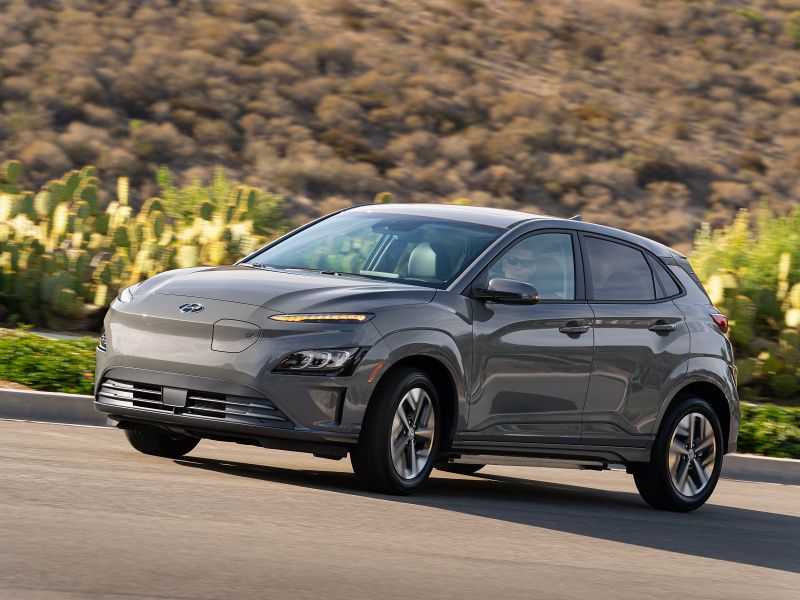
2022 Hyundai Kona EV ・ Photo by Hyundai
The 2022 Hyundai Kona Electric captures all the positive attributes of the conventional Kona crossover and adds the benefit of battery-electric power. Yes, the electric drive system adds to the Kona’s price, but the Kona EV offers value in much the same way its conventional sibling does. It is a versatile small crossover that offers a driving experience that is very car-like. For 2022, Hyundai has mellowed out the previous Kona Electric’s distinctive looks with a revised front end and numerous other changes that up the value quotient of the vehicle still more. Interestingly, the Kona EV’s most challenging competition comes from a vehicle within the Hyundai portfolio — the new Hyundai Ioniq 5. The Kona EV has a fun-to-drive personality that in many ways splits the difference between an economical small crossover and a much more expensive electric car. With a handy footprint and quick acceleration, the Kona Electric can be an urban warrior. And its 258-mile range on a charge makes road trips a reasonable possibility. While the Kona EV has a compact footprint, it will accommodate five passengers and a lot of stuff.
Exterior Style
One thing that has always set the Kona EV apart from its Kona siblings was its exterior styling. That is still the case in the 2022 model, but Hyundai has facelifted the Kona EV with a less controversial nose. Previously the area occupied by a grille had been filled with a solid mass covered with dimples, reminding some of a giant golf ball. Thankfully, that is gone, replaced by a more conventional smooth design interrupted only by the convenient access to the charging receptacle. The Kona EV is also treated to new headlights and daytime running lights that give it an revised “lighting signature.” In another move to make the Kona EV look more like a conventional vehicle, the lower fascia has an open area with horizontal strakes just as you might see on a gasoline-powered car. The facelift is accompanied by a buttlift that gives the Kona EV a rear fascia that carries the “strakes” motif of the front. The taillights have been revised, and vents have been added to the fenders. The Kona EV gets a new wheel design as well.
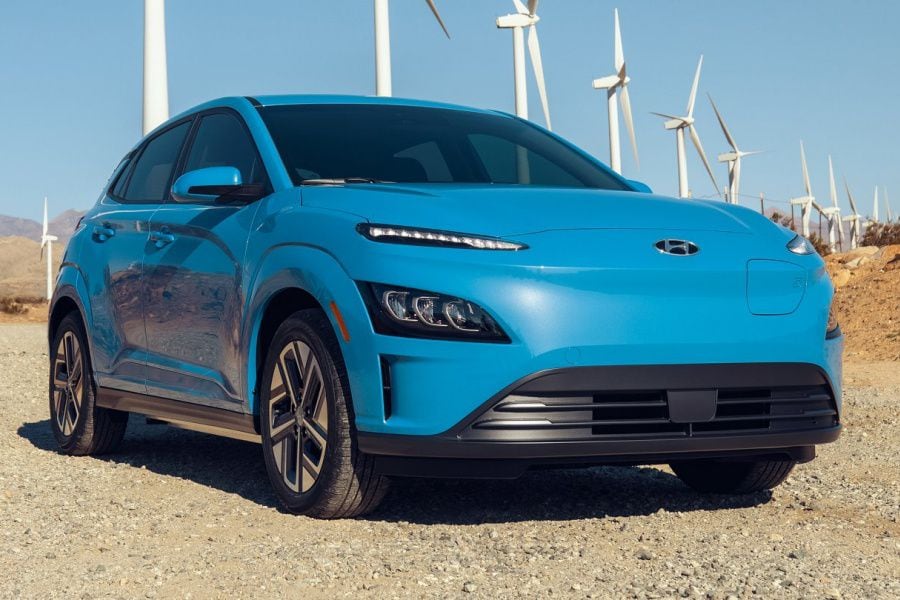
Photo by Hyundai
Interior Design
For a vehicle with compact dimensions, the Hyundai Kona Electric offers a great deal of interior room. For 2022, the Kona’s interior has been revamped, and the changes are more substantial than those of the typical mid-cycle change. The vehicle gets a new center console that is not connected to the dashboard, and that is intended to highlight the horizontal nature of the dash. The dash also is the recipient of large digital display screens as we’ll detail later in this article. Hyundai has added ambient lighting for the cupholders and footwells and has given the interior some new finishes. The optional electronic parking brake opens up some interior space previously occupied by the manual brake handle. The new interior has increased second-row legroom and the rear cargo area, although we’d prefer to see better stowage of the charging cable than under the cargo net on the floor of the luggage area. As a final touch, access to the USB ports has been improved for the rear-seat passengers.
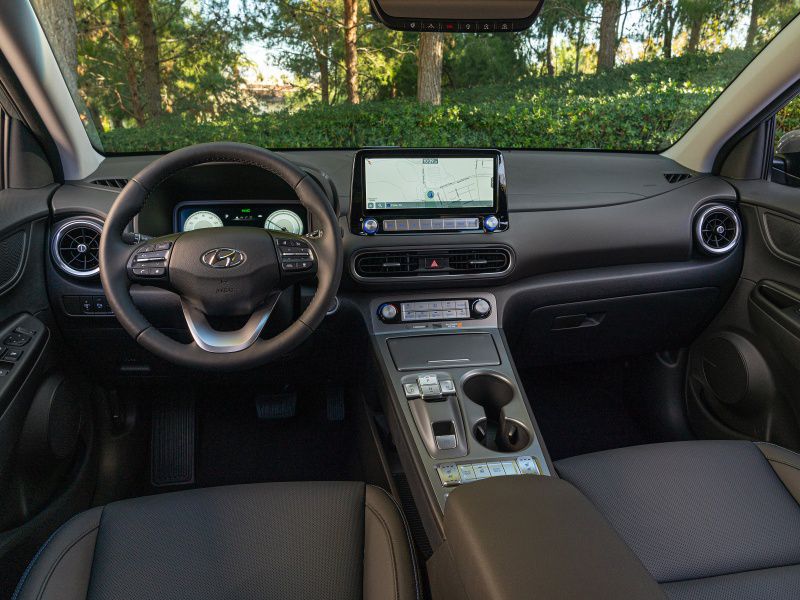
Photo by Hyundai
Powertrain
The Hyundai Kona Electric is quick and powerful, benefiting from the instant torque of its single electric motor. The permanent-magnet synchronous electric motor develops 201 horsepower (150 kW) and 291 lb-ft of peak torque. That is an enormous amount of torque versus the torque that is typically available from a small displacement gasoline engine. The motor drives the front wheels of the Kona Electric. It draws on power stored in a 64 kWh lithium-ion battery pack. The battery system is liquid-cooled and operates at 356 volts. In comparison, the Hyundai Kona Turbo has a turbocharged four-cylinder engine that develops 195 horsepower, but the driving demeanor of that vehicle is far different from the Kona Electric.
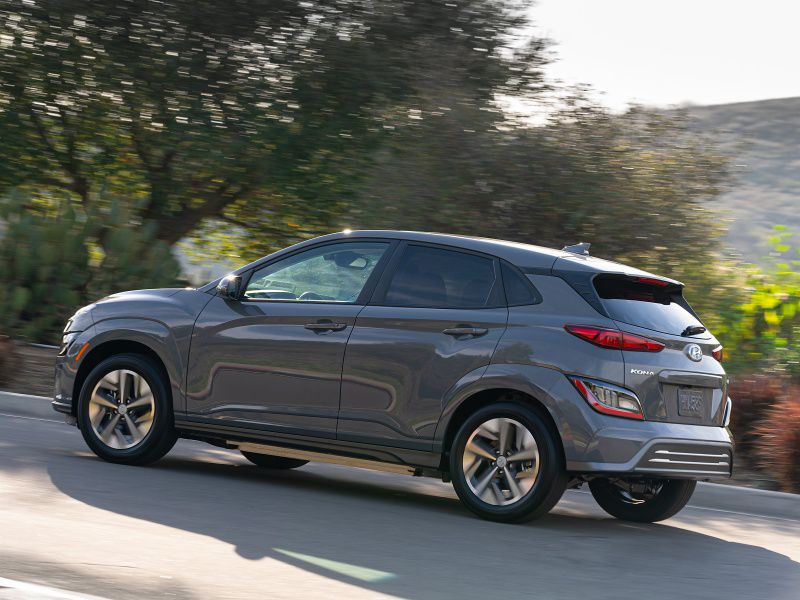
Photo by Hyundai
Driving Impressions
The conventional Hyundai Kona is designed to provide utility and versatility at a low price. At the same time, it delivers more driving fun than you might imagine. When equipped with ther turbocharged engine, it really comes alive. The Kona Electric offers a similar amount of horsepower and much more low-end torque. But the driving experience is different. In the first place, the Kona EV is quicker than the turbo in a zero-to 60-mph sprint. But that isn’t the only difference; the Kona Electric accelerates in a smooth, silent manner seeming to gain momentum as it goes forward. In a similar situation there is a lot of commotion, noise and gear-charging when accelerating in a Kona turbo. In all-around driving, you feel the weight of the Kona Electric’s battery pack. The Kona EV weighs 500 pounds more than a loaded Kona with all-wheel drive and the turbocharged engine. While the Kona EV’s handling is interesting, enthusiast drivers might prefer the conventional Kona.
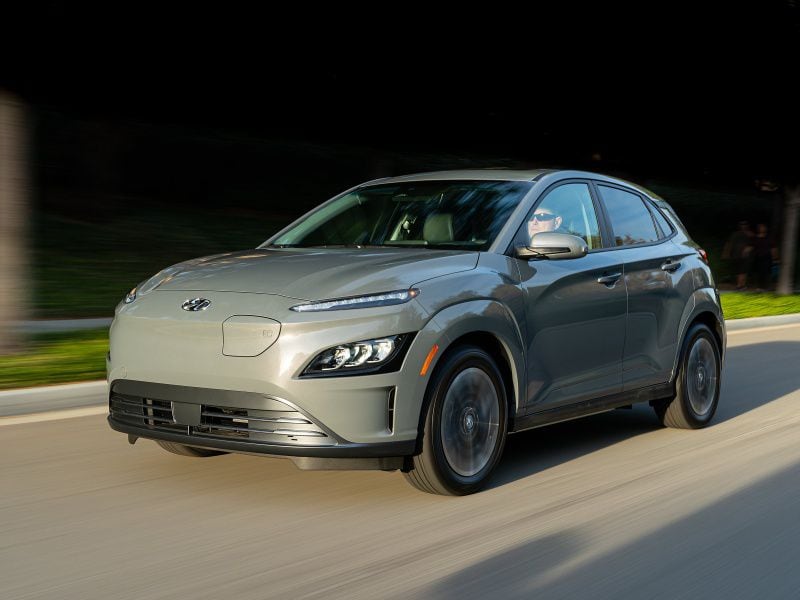
Photo by Hyundai
Cargo & Towing
Despite its short length, the Hyundai Kona Electric offers a large cabin and impressive cargo-carrying ability. With the rear seatback folded, it offers 45.8 cubic feet of cargo volume. And it delivers a robust 19.2 cubic feet with the second row bench seat in use. In comparison, the Kia Soul offers 62.1 cubic feet of cargo volume with the rear setback folded. And it has 24.2 cubic feet of cargo space with the second-row bench seat in use. The 2022 Subaru Impreza sedan has 12.3 cubic feet of trunk space. The Impreza hatchback has 20.8 cubic feet of cargo area behind the second row and a generous 55.3 cubic feet with the rear seats folded. This is another indication that the Hyundai Kona Electric is as much a hatchback as it is an SUV. Like most EVs, the Kona Electric is not recommended for towing.
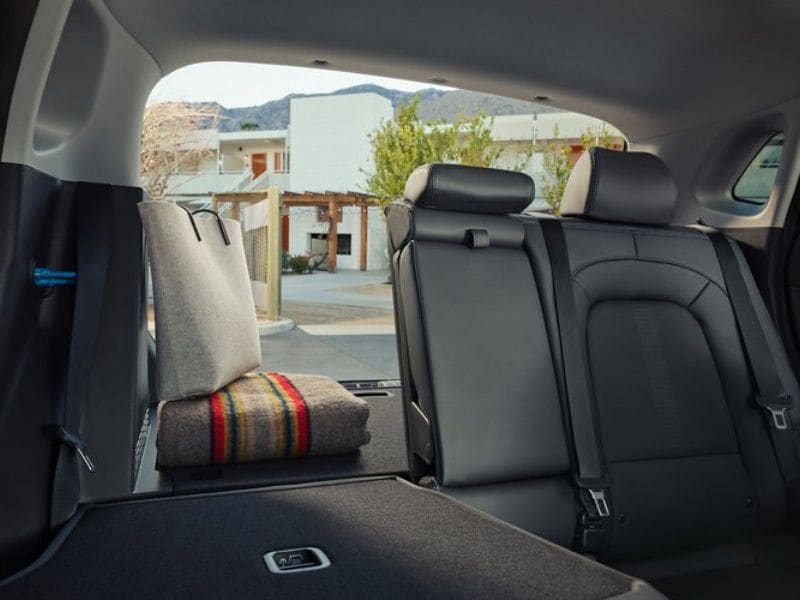
Photo by Hyundai
Infotainment &Technology
For 2022, the Hyundai Kona Electric gets the benefit of new infotainment and driver-information displays. The most obvious changes are the addition of a 10.25-inch digital instrument and driver information cluster and an available 10.25-inch information display. The new infotainment display has a split-screen that helps the driver select the intended function quickly and efficiently. The system supports multiple Bluetooth connections, but it doesn’t support wireless Apple CarPlay and wireless Android Auto. Interestingly, the 8-inch display in the Kona Electric SEL trim does support both wireless Apple CarPlay and Android Auto. One key improvement to the Blue Link connectivity system is cloud storage for some vehicle settings and driver preferences. New vehicle status notifications will alert the driver with a text if the doors are left unlocked or if the windows are left open. For Kona Electric owners who charge at home, one of the most useful features is the ability to manage their charging schedules. Owners get vehicle-charging options that they can select while in the car and manage remotely via a smartphone. The simplest option is charging that begins as soon as the Kona Electric is plugged in. Owners whose electric rates are lower at off-peak times may want to schedule charging during those periods to reduce cost as well as reduce peak demand on the electricity grid.
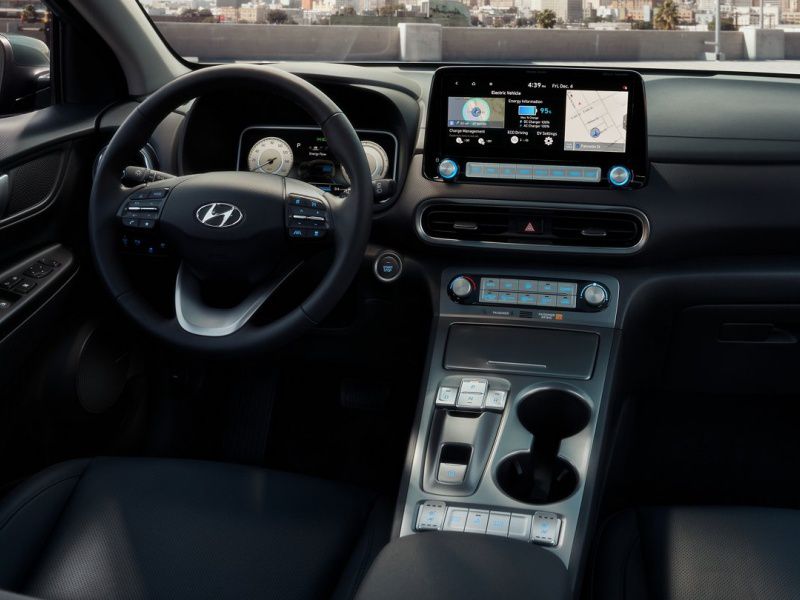
Photo by Hyundai
Safety & Driver Aids
The 2022 Hyundai Kona offers a degree of safety that is uncommon in such an inexpensive vehicle. The National Highway Traffic Safety Administration (NHTSA) gave the 2022 Soul a five-star rating in its 5-Star Safety Rating Program, the top honor. The Insurance Institute for Highway Safety gave the Kona Good ratings in all the Crashworthiness measures. The 2022 Kona retains the available Advanced Driving Assistance Systems that were available on the previous 2021 model, and it adds another useful feature: highway drive assist, which helps the Kona stay in the center of the lane at a set distance from the traffic ahead. The Kona Electric on theater hand is not nearly as well equipped with electronic driver safety systems, since many are tied to conventional gasoline powertrain and braking operations. The Limited trim of the Hyundai Electric has it includes adaptive cruise control with stop and go, forward collision avoidance assist with pedestrian and cyclist detection, and high-beam headlight assist.
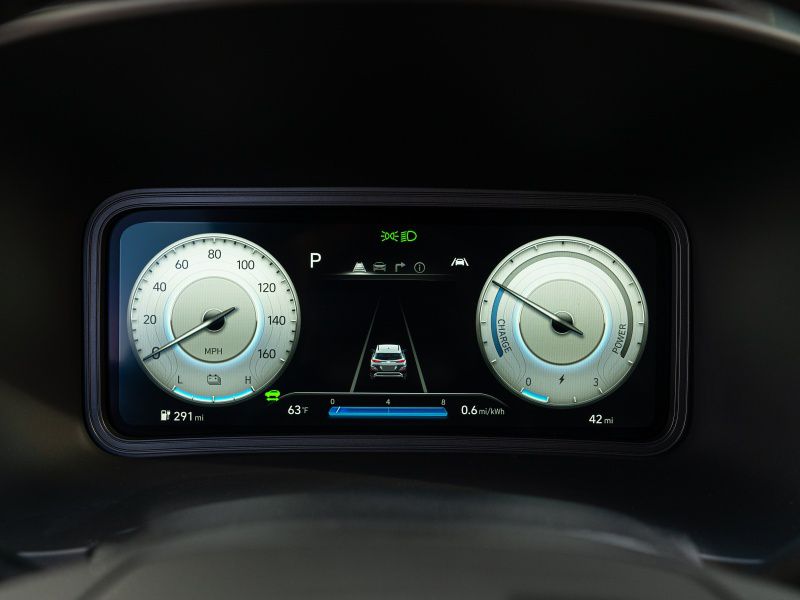
Photo by Hyundai
Range, Charging & Fuel Economy Equivalent
The Hyundai Kona Electric goes a long way toward addressing the range and charging time issues that have dissuaded many consumer from buying an EV. The Kona Electric offers 258 miles of driving range on a full charge. When on the go, drivers can utilize the Kona Electric’s Level 3 DC fast-charge rate. In this mode, the Kona EV can charge from 10 percent to 80 percent in approximately 47 minutes using its SAE-Combo charging port. This fast-charging capability is standard on the Kona Electric. With Level 2 at-home charging, situations considerably different. The Kona Electric charges from 10 percent to 100 percent in approximately nine hours and 15 minutes. This implies overnight charging with the recommendation that you sleep in. The charging port is located in the front grille which is convenient in head-in parking situations. A battery warmer system is standard on the Kona Electric SEL Convenience trim and above. The system helps prevent excessively long battery-charging intervals in cold temperatures. In addition, in Winter Mode, the battery warmer can minimize battery-power losses due to low winter temperatures. The Kona Electric's estimated MPGe is 132 miles in the city, 108 miles on the highway, and 120 miles combined based on Hyundai’s test results.
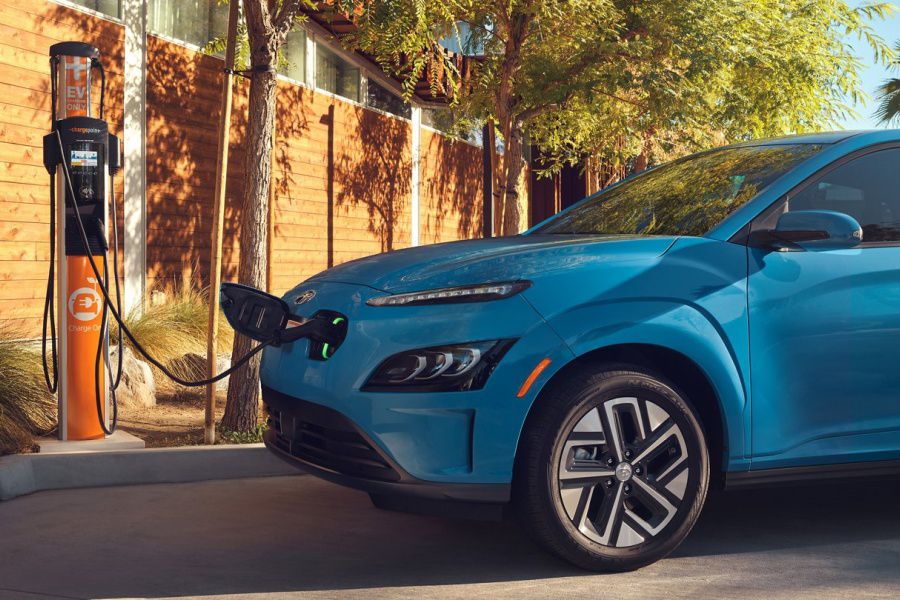
Photo by Hyundai
Trim Levels
The 2022 Hyundai Kona Electric is available in two trim levels — SEL and Limited. The Kona Electric SEL is the less expensive of the two models and is much more basic than the Limited. For instance, it has an 8-inch touchscreen infotainment unit versus the 10.25-inch touchscreen in the Limited. It also lacks some of the advanced drive-assistance systems that are featured on the Limited trim. From a comfort and convenience standpoint, however, the Kona Electric SEL is well equipped. It has remote keyless entry, proximity key, push button start, rear window wiper/washer, Drive Mode Select, and a 10.25-inch digital instrument cluster. The Kona Electric Limited serves up much more in terms of comfort and convenience. It includes Harman Kardon premium audio with eight speakers, leather seats, a heated steering wheel, ventilated front seats, and remain-sensing wipers. It also has a 10.25-inch touchscreen infotainment with integral navigation system and multi-device Bluetooth. In terms of advanced driver-assistance systems, it has adaptive cruise control with stop and go, forward collision avoidance assist with pedestrian and cyclist detection, and high-beam headlight assist.
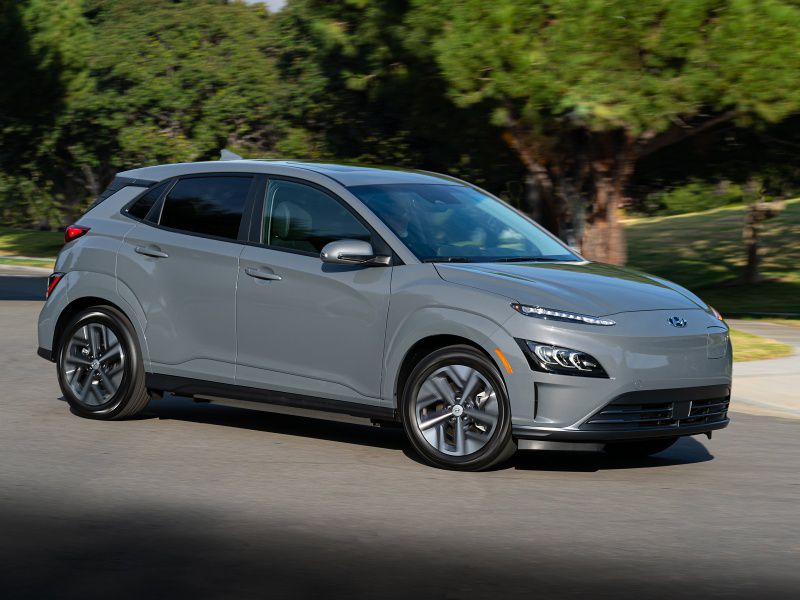
Photo by Hyundai
Pricing & Value
The conventionally powered Hyundai Kona with a base price right around $25,000 is a bargain in today’s market. It offers versatility and room for five passengers. Even when optioned-up, it can still be purchased for well less than $30,000. The Kona Electric is a vehicle of another color. Added emission-free battery-electric propulsion involves the addition of very expensive components. So the 2022 Hyundai Kona Electric SEL has a base price of $34,000. The Convenience Package with several worthwhile additions increases the price by $3,500. Suddenly the inexpensive Kona isn’t inexpensive any more... That issue is exacerbated by the heavily equipped Limited trim. It is filled with stuff a lot of people would like to have on their cars, but its price is even higher. It has a base price of $42,500; that is a lot of coin for a small EV whose tech is currently being eclipsed by another battery-electric in the Hyundai lineup, the Ioniq 5. The saving grace is the $7,500 federal tax credit that might save you serious money on your Kona Electric purchase. When you drive the Kona Electric, drive the Ioniq 5, too.
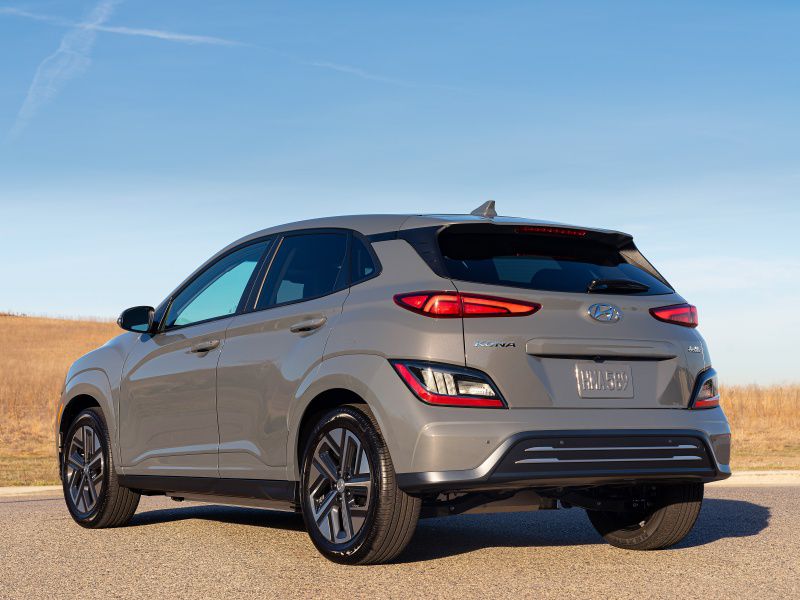
Photo by Hyundai